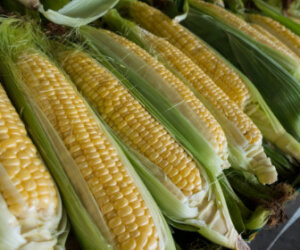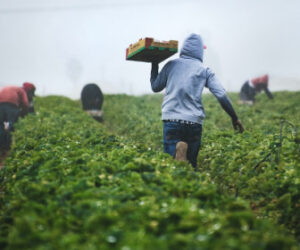So What Exactly Is Glyphosate?
Glyphosate is the active ingredient in Roundup, the most commonly used weedkiller in the world.
Nearly 300 million pounds of glyphosate-based herbicide are sprayed on farms—and food—every year. It’s almost impossible to avoid, but what actually is Glyphosate and what does it do? More importantly, what does it do to us?
The following is an excerpt from Toxic Legacy by Stephanie Seneff. It has been adapted for the web.
Evidence of Harm
Glyphosate-based herbicides are used to control a wide variety of weeds that grow among food crops, residential lawns, gardens, public parks, roadsides, conservation lands, wildlife areas, rangelands, forests, waterways, and more1. These herbicides come under a long list of names, including Roundup, Roundup Ultra, Roundup Pro, AquaMaster, Aqua Neat, Polado, Accord, Rodeo, Touchdown, Backdraft, Expedite, EZ-Ject, Glyfos, Laredo, Buccaneer Plus, and Wrangler, among others. These products contain a variety of chemicals. But in all of them, glyphosate is the primary ingredient, making up 36–48 percent of the product.
Although it’s used as a weed killer today, glyphosate was first patented by the Stauffer Chemical Company in 1961 as a chelating agent to strip mineral deposits off pipes and boilers in commercial hot-water systems2. Then in 1968, Monsanto patented glyphosate for a totally different application, as an herbicide for use in agriculture3. It was then patented a third time (again by Monsanto) in the early 2000s, this time as an oral antibiotic4. All of these applications, as a chelator, an herbicide, and an antibiotic, play a role in the chemical’s unique and diabolical impact on human health.
With the legal right to its exclusive use in agriculture, Monsanto began selling a glyphosate-based herbicide, Roundup, in the mid-1970s. Roundup was marketed as being considerably less toxic than other common herbicides, such as dicamba and 2,4-D, less persistent in the soil, and safer for humans, animals, and the environment. By reducing the need for tillage, it was described as “the perfect environmental solution at the perfect time . . . one of, if not the safest, herbicides in history.”5
As a nonselective herbicide, it would kill almost any plant it came in contact with.
Farmers had to be cautious in its application. In the 1980s, Monsanto began investing in a brilliant new biotechnology research and development program. The company’s genetic engineers spliced microbial genes into common crops to make them resistant to Roundup. We generally use the term genetically modified organisms (GMOs) to describe these types of crops. These “Roundup Ready” GMO crops transformed the herbicide from a home run to a grand slam. By the time glyphosate-resistant crops came on the market in 1996, they were heralded as a major advance in agriculture and biotechnology—a promise to end hunger and feed the world.
And instead of using glyphosate carefully and selectively, farmers could now douse entire fields with it and only the weeds, not the Roundup Ready crops, would die.
Sales of Roundup Ready seed, beginning with soybeans and corn, and followed by canola, sugar beets, cotton, and alfalfa, skyrocketed. So did sales of Roundup. By 2014, glyphosate use in the United States had risen to 125 million kilograms (about 138,000 tons), up 15-fold from the 1970s6. Today nearly 150,000 tons of glyphosate are sprayed onto American crops every year. That’s the equivalent of one pound of glyphosate per year for every person in the United States7.
 From an industry standpoint, there was only one big monkey wrench in the weed-killing glory of glyphosate: Living beings want to survive. Organisms that can withstand poisons will flourish and multiply. While glyphosate would kill weeds indiscriminately, certain weeds were less sensitive—or became so over time. These “superweeds” begin to dominate an ecosystem, crowding out crops, requiring more and more glyphosate, or different herbicides entirely, to kill them off. The solution? Use more glyphosate! Since 1974, about 8.6 billion kilograms—some 19 billion pounds—of glyphosate have been applied worldwide8.
From an industry standpoint, there was only one big monkey wrench in the weed-killing glory of glyphosate: Living beings want to survive. Organisms that can withstand poisons will flourish and multiply. While glyphosate would kill weeds indiscriminately, certain weeds were less sensitive—or became so over time. These “superweeds” begin to dominate an ecosystem, crowding out crops, requiring more and more glyphosate, or different herbicides entirely, to kill them off. The solution? Use more glyphosate! Since 1974, about 8.6 billion kilograms—some 19 billion pounds—of glyphosate have been applied worldwide8.
GMO technology is a powerful tool that allows genes from other species (usually microbial genes) to be introduced into the genome of a plant. Such novel genes can supply the plant with beneficial advantages—frost resistance, for example, or drought tolerance. To produce glyphosate resistance, a gene from a bacterium with a version of EPSP synthase insensitive to glyphosate is inserted into the crop’s genome. The amount of glyphosate used on GMO crops has increased dramatically over the past two decades. Given the hand-in-glove relationship between glyphosate and genetically modified crops, you might think it’s easy to avoid glyphosate by avoiding GM foods. In fact, the highest levels of glyphosate have consistently been found in non-GMO foods derived from wheat, oats, and legumes. Why? Because these crops are commonly sprayed with glyphosate as a desiccant right before harvest, causing the plant to drop its leaves and dry out so it is easier to harvest. Glyphosate forces the crop to go to seed as it’s dying, which synchronizes seed production and increases yield. Many other crops are desiccated with glyphosate, including barley and rye, and oily crops such as canola, safflower, sunflower, linseed and flax, that are used for vegetable oil production. At this point in the plant’s life cycle, it is not a problem if glyphosate kills it. In fact, that is the intent.
The astute shopper should be aware of the difference between the label “non-GMO” and “certified organic.” By law, glyphosate cannot be used on certified organic crops. Even if a food is certified organic, however, it doesn’t necessarily mean the food is glyphosate-free. Though organically grown foods usually test at much lower levels for glyphosate than conventionally grown food, it’s nearly impossible to avoid glyphosate in the soil, in animal manure, in rainwater, and in wind drift.
Glyphosate-based herbicides have become so pervasive that even food from farms nowhere near where glyphosate is sprayed can be contaminated.
When the FDA tested 28 samples of honey in 2017, 100 percent contained glyphosate9. Two years later, government scientists in Canada found the herbicide in 197 out of 200 honey samples they tested10. Bees don’t understand property boundaries. They forage freely, picking up bits of herbicides and insecticides as they fly from flower to flower, bringing it back to their hives.
Glyphosate has been showing up in human urine since 1993, well before genetically engineered Roundup Ready crops were in widespread use11. But while only 12 percent of Americans tested positive for glyphosate exposure from 1993 to 1996, at least 70 percent of Americans test positive today12. As high as that number sounds, it’s likely an underestimate. Of the several dozen patients one doctor in southern Oregon tested for glyphosate—most of whom were self-described health nuts who eat organic food—100 percent, including the doctor himself, came back positive13. People who eat a predominantly organic  diet have significantly less glyphosate in their urine than people who consume mostly conventional foods, and people who are healthy have significantly lower levels of glyphosate in their urine than those who are chronically ill14. Still, glyphosate is nearly impossible to completely avoid.
diet have significantly less glyphosate in their urine than people who consume mostly conventional foods, and people who are healthy have significantly lower levels of glyphosate in their urine than those who are chronically ill14. Still, glyphosate is nearly impossible to completely avoid.
We are all being exposed to glyphosate—primarily from the food we eat, but also from the water we drink and bathe and swim in; the lawns we walk on; the parks children play at; and probably even the medicines and nutraceuticals we take. Glyphosate is also in the air—a particular risk to people who live in farming communities—and it has been shown to be a contributing factor in rising rates of lung damage, asthma, and allergies15. When a chemical is so pervasive, so ubiquitous, so nearly impossible for even the most diligent person to avoid, it is especially incumbent on regulatory agencies and elected officials to ask tough questions, conduct rigorous investigations and hearings, and put the health and safety of its populace first. But in the case of glyphosate, this hasn’t happened.
It’s an abdication of responsibility and a disgrace to democracy.
Notes
1. United States Environmental Protection Agency, “Glyphosate,” https://www.epa.gov/ingredients-used-pesticide-products/glyphosate.
2. US patent number 3160632; filed: January 30, 1961; awarded: December 8, 1964.
3. US patent number 3455675 A; filed: June 25, 1968; awarded: July 15, 1969.
4. US patent number 20040077608 A1; filed: August 29, 2003; awarded: April 22, 2004.
5. Roundup. “The History of Roundup,” https://www.roundup.ca/en/rounduphistory.
6. C. M. Benbrook, “Trends in Glyphosate Herbicide Use in the United States and Globally,” Environmental Sciences Europe 28 (2016): 3, https://doi.org/10.1186/s12302-016-0070-0.
7. Charles M. Benbrook, “Trends in Glyphosate Herbicide Use in the United States and Globally,” Environmental Sciences Europe 28 (2016): 3, https://doi.org/10.1186/s12302-016-0070-0.
8. Marie-Pier Hébert et al., “The Overlooked Impact of Rising Glyphosate Use on Phosphorus Loading in Agricultural Watersheds,” Frontiers in Ecology and the Environment 17, no. 1 (2019): 48–56, https://doi.org/10.1002/fee.1985.
9. Narong Chamkasem and John D Vargo, “Development and Independent Laboratory Validation of an Analytical Method for the Direct Determination of Glyphosate, Glufosinate, and Aminomethylphosphonic Acid in Honey by Liquid Chromatography Tandem Mass Spectrometry,” Journal of Regulatory Science 5, no. 2 (2017): 1–9, https://doi.org/10.21423/jrs-v05n02p001.
10. Thomas S. Thompson et al., “Determination of Glyphosate, AMPA, and Glufosinate in Honey by Online Solid-Phase Extraction-Liquid Chromatography-Tandem Mass Spectrometry,” Food Additives & Contaminants: Part A 36, no. 2 (2019): 1–13, https://doi.org/10.1080/19440049.2019.1577993.
11. Melissa J. Perry et al., “Historical Evidence of Glyphosate Exposure from a US Agricultural Cohort,” Environmental Health 18 (2019): 42, https://doi.org/10.1186/s12940-019-0474-6.
12. Paul J. Mills et al., “Excretion of the Herbicide Glyphosate in Older Adults between 1993 and 2016.” JAMA 318, no. 16 (2017): 1610–11, https://doi.org/10.1001/jama.2017.11726.
13. Personal communication between Dr. Chris Chlebowski and Jennifer Margulis, July 17, 2020.
14. Monika Krüger et al., “Detection of Glyphosate Residues in Animals and Humans,” Journal of Environmental & Analytical Toxicology 4 (2014): 210, https://doi.org/10.4172/2161-0525.1000210.
15. Sudhir Kumar et al., “Glyphosate-Rich Air Samples Induce IL-33, TSLP and Generate IL-13 Dependent Airway Inflammation,” Toxicology 0 (2014): 42–51, https://doi.org/10.1016/j.tox.2014.08.008.
